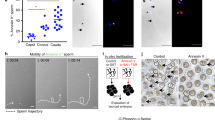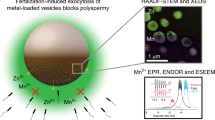Abstract
In many cells, receptor activation initiates sustained Ca2+ entry which is critical in signal transduction1. Mammalian transient receptor potential (Trp) proteins, which are homologous to the Drosophila photoreceptor-cell Trp protein, have emerged as candidate subunits of the ion channels that mediate this influx. As a consequence of overexpression, these proteins produce cation currents that open either after depletion of internal Ca2+ stores or through receptor activation2. However, determining the role of endogenous Trp proteins in signal transduction is complicated by the absence of selective antagonists. Here we examine Trp function during sperm–egg interaction. The sperm acrosome reaction is a Ca2+-dependent secretory event that must be completed before fertilization. In mammals, exocytosis is triggered during gamete contact by ZP3, a glycoprotein constituent of the egg's extracellular matrix, or zona pellucida (ZP). ZP3 activates trimeric G proteins and phospholipase C and causes a transient Ca2+ influx into sperm through T-type Ca2+ channels3. These early responses promote a second Ca2+-entry pathway, thereby producing sustained increases in intracellular Ca2+ concentration ([Ca2+]i) that drive acrosome reactions4. Our results show that Trp2 is essential for the activation of sustained Ca2+ influx into sperm by ZP3.
This is a preview of subscription content, access via your institution
Access options
Subscribe to this journal
Receive 12 print issues and online access
$209.00 per year
only $17.42 per issue
Buy this article
- Purchase on Springer Link
- Instant access to full article PDF
Prices may be subject to local taxes which are calculated during checkout




Similar content being viewed by others
References
Parekh, A. B. & Penner, R. Physiol. Rev. 77, 901–930 (1997).
Harteneck, C., Plant, T. D. & Schultz, G. Trends Neurosci. 23, 159–166 (2000).
Wassarman, P. M. Cell 96, 176–183 (1999).
O'Toole, C. M. B., Arnoult, C., Darszon, A., Steinhardt, R. A. & Florman, H. M. Mol. Biol. Cell 11, 1571–1584 (2000).
Wissenbach, U., Schroth, G., Phillipp, S. & Flockerzi, V. FEBS Lett. 429, 61–66 (1998).
Vannier, B. et al. Proc. Natl Acad. Sci. 96, 2060–2064 (1999).
Vannier, B., Zhu, X., Brown, D. & Birnbaumer, L. J. Biol. Chem. 273, 8675–8679 (1998).
Liman, E. R., Corey, D. P. & Dulac, C. Proc. Natl Acad. Sci. 96, 5791–5796 (1999).
Merritt, J. E., Jacob, R. & Hallam, T. J. J. Biol. Chem. 264, 1522–1527 (1989).
Meizel, S. & Turner, K. O. J. Exp. Zool. 267, 350–355 (1993).
Publicover, S. J. & Barratt, C. L. R. Hum. Reprod. 14, 873–879 (1999).
Bleil, J. D. & Wassarman, P. M. Dev. Biol. 95, 317–324 (1983).
Mason, M. J. & Grinstein, S. Biochem. J. 296, 33–39 (1993).
Putney, J. W. Proc. Natl Acad. Sci. 96, 14669–14671 (1999).
Jan, C. R., Ho, C. M., Wu, S. N. & Tseng, C. J. Naunym-Schmiedeberg's Arch. Pharmacol. 359, 92–101 (1999).
Liu, X. et al. J. Biol. Chem. 275, 3403–3411 (2000).
Philipp, S. et al. J. Biol. Chem. 275, 23965–23972 (2000).
Li, H-S., Xu, X-Z. S. & Montell, C. Neuron 24, 261–273 (1999).
Xu, X-Z. S., Li, H-S., Guggino, W. B. & Montero, M. Cell 89, 1155–1164 (1997).
Hofmann, T., Schaefer, M., Schultz, G. & Gudermann, T. Biochem. J. 351, 115–122 (2000).
Blackmore, P. F. Cell Calcium 14, 53–60 (1993).
Santi, C. M., Santos, T., Hernandez-Cruz, A. & Darszon, A. J. Gen. Physiol. 112, 33–53 (1998).
Walensky, L. D. & Snyder, S. H. J. Cell Biol. 130, 857–869 (1995).
Dragileva, E., Rubinstein, S. & Breitbart, H. Biol. Reprod. 1226–1234 (1999).
Kiselyov, K. et al. Nature 396, 478–482 (1998).
Arnoult, C. et al. Proc. Natl Acad. Sci. 96, 6757–6762 (1999).
Bleil, J. D. & Wassarman, P. M. Cell 20, 873–882 (1980).
Litscher, E. S. & Wassarman, P. M. in A Comparative Methods Approach to the Study of Oocytes and Embryos (ed. Richter, J. D.) 10–22 (Oxford Univ. Press, New York,1999).
Rockwell, P. L. & Storey, B. T. Mol. Reprod. Dev. 54, 418–428 (1999).
Horn, R. & Marty, A. J. Gen. Physiol. 94, 145–159 (1988).
Acknowledgements
We thank P. Wassarman for discussions and for providing ZP3 for initial experiments, and J. Lawrence and G. Stein for access to microscopes. This work was supported by grants from the N.I.H. (to H.M.F. and L.B.).
Author information
Authors and Affiliations
Corresponding author
Rights and permissions
About this article
Cite this article
Jungnickel, M., Marrero, H., Birnbaumer, L. et al. Trp2 regulates entry of Ca2+ into mouse sperm triggered by egg ZP3. Nat Cell Biol 3, 499–502 (2001). https://doi.org/10.1038/35074570
Received:
Revised:
Accepted:
Published:
Issue Date:
DOI: https://doi.org/10.1038/35074570
This article is cited by
-
RNA-seq analysis reveals TRPC genes to impact an unexpected number of metabolic and regulatory pathways
Scientific Reports (2020)
-
The Catsper channel and its roles in male fertility: a systematic review
Reproductive Biology and Endocrinology (2017)
-
Constitutive calcium entry and cancer: updated views and insights
European Biophysics Journal (2017)



